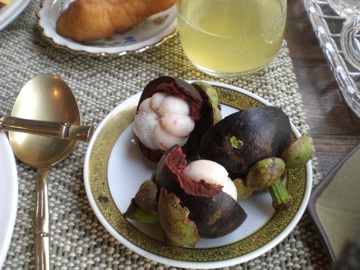BANGKOK, THAILAND: Informal Architecture and Mangosteen
 For my time in Southeast Asia I flew in and out of Thailand (thank you, Star Alliance frequent flier miles). Because of that I started my trip with a few vacation days as a first attempt at unwinding and shifting from normal work habits. Bangkok has a reputation as huge and dirty, traffic-clogged, brimming with intense contrasts of wealth and poverty, and packed in some sections with hippy tourist masses. All true, but I loved my few days in the old central city. The slightly chaotic, informal way the city is put together plus the tropical energy felt easy and comfortable. Some parts of my past life as student and curator in Houston prepped me, perhaps. But unlike Houston, Bangkok hosts abundant streetlife, with fluid boundaries between inside and outside space: shops open to the street, food stalls in alleys with two or three little plastic tables clustered around, people setting out huge plants to line the sidewalk with green or using their porches along the canal as closets. I got interested in this informal architecture, especially in relation to eating and drinking. There's a real economy of means here as people colonize bits of sidewalk or sidestreets to make efficient cooking zones and hospitable spaces to eat. Each vendor has its special dish: pad thai, perhaps, or sticky rice in a banana leaves. (More on this kind of informal food architecture and its potential relation to art when I write about Indonesia...)
For my time in Southeast Asia I flew in and out of Thailand (thank you, Star Alliance frequent flier miles). Because of that I started my trip with a few vacation days as a first attempt at unwinding and shifting from normal work habits. Bangkok has a reputation as huge and dirty, traffic-clogged, brimming with intense contrasts of wealth and poverty, and packed in some sections with hippy tourist masses. All true, but I loved my few days in the old central city. The slightly chaotic, informal way the city is put together plus the tropical energy felt easy and comfortable. Some parts of my past life as student and curator in Houston prepped me, perhaps. But unlike Houston, Bangkok hosts abundant streetlife, with fluid boundaries between inside and outside space: shops open to the street, food stalls in alleys with two or three little plastic tables clustered around, people setting out huge plants to line the sidewalk with green or using their porches along the canal as closets. I got interested in this informal architecture, especially in relation to eating and drinking. There's a real economy of means here as people colonize bits of sidewalk or sidestreets to make efficient cooking zones and hospitable spaces to eat. Each vendor has its special dish: pad thai, perhaps, or sticky rice in a banana leaves. (More on this kind of informal food architecture and its potential relation to art when I write about Indonesia...)And oh, there was unbelievable fruit. On my first day in Thailand I got obsessed with mangosteen. I'd never seen it before, but it's beautiful, slightly smaller then a tennis ball with a smooth thick purplish shell, capped with a bright green stem. Once you crack the shell open, there's a beautiful contrast between that purple and the white sections of fruit inside. It looks like the moon and tastes sweet and tender. Moonlike, it is known in the region as the queen of fruits, as a cooling fruit to be eaten along with durian -- a.k.a the king of fruits -- to counteract the durian's heat. (Later, I tried and hated durian. It wasn't the infamous smell, it was the custard texture.) I'm going to miss mangosteen back in North America but it's reassuring to be reminded that not all fruit has yet been bred and/or packaged into standardized, monoculture products that are universally available during all seasons and across all distances.
Categories
Research Travel , Thailand0 TrackBacks
Listed below are links to blogs that reference this entry: BANGKOK, THAILAND: Informal Architecture and Mangosteen.
TrackBack URL for this entry: https://blogs.uchicago.edu/cgi-bin/mt/mt-tb.cgi/157
Leave a comment